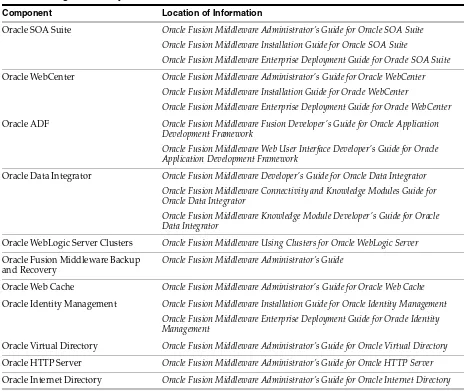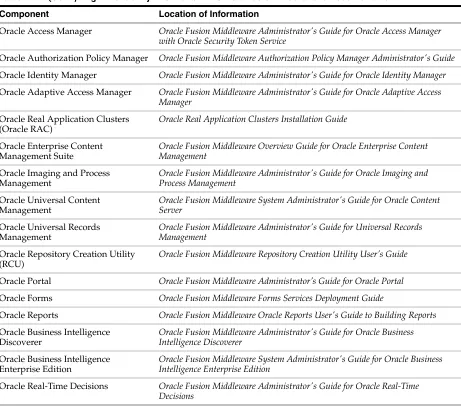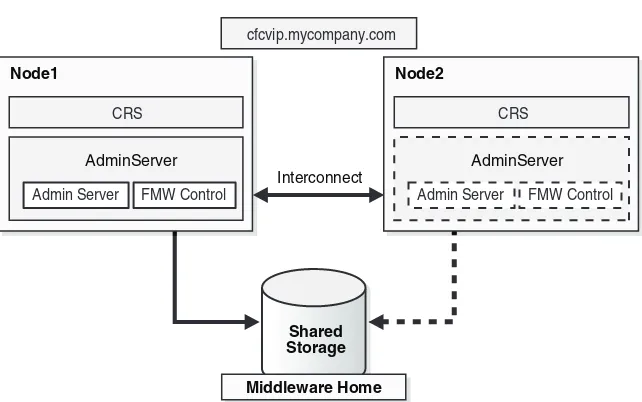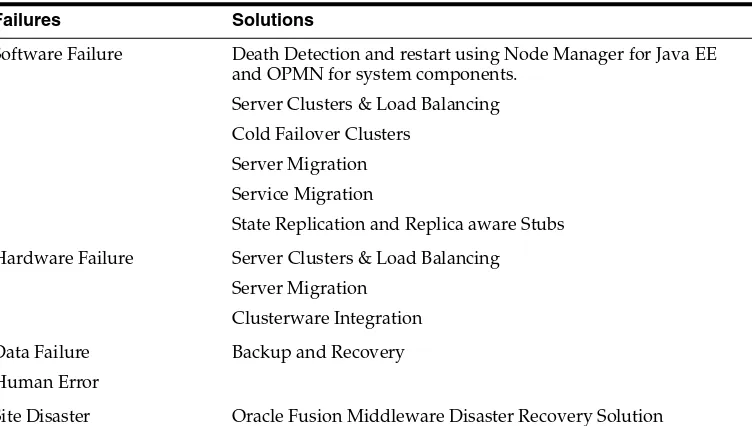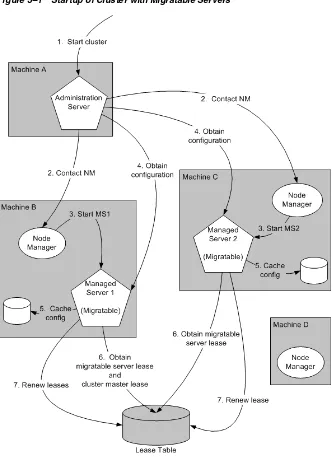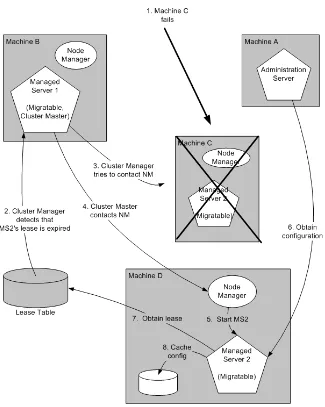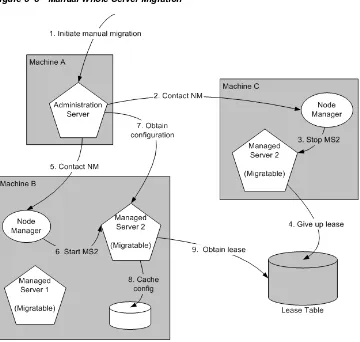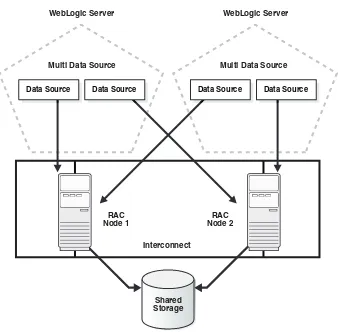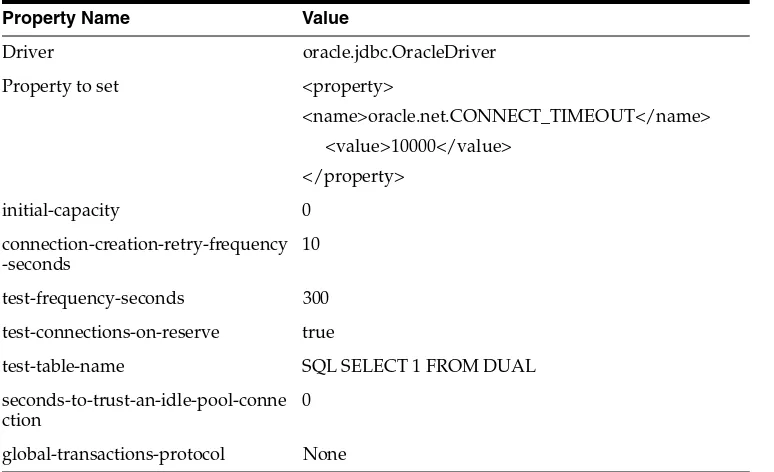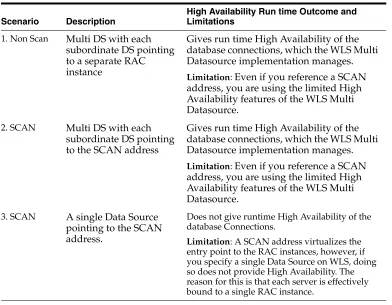High Availability Guide
11g Release 1 (11.1.1)
E10106-15Copyright © 2003, 2011, Oracle and/or its affiliates. All rights reserved.
Primary Author: Christine Ford
Contributing Author: Fermin Castro, Shailesh Dwivedi, Michael Blevins, Pradeep Bhat, Michael Rhys, Samrat Ray, Jeni Ferns, Richard Delval, Bharath K. Reddy, Susan Kornberg, Joe Paul, Ajay Keni, Amit Sharma, Vasuki Ashok, Olaf Stullich, Jingjing Wei, Olfat Aly, Eileen He, Ramaprakash Sathyanarayan, Apurv Chandra, Atika Jain, Buddhika Kottahachchi, Arun Theebaprakasam, Rajiv Jaisankar, Vinay Kalra, Daniel Shih, Pratima Gogineni, Russ Hodgson, Christopher Johnson, Pramodini Gattu, Gururaj BS, Ben Gelernter, Peter Jacobsen.
Contributor: Van Sioung Ng Yan Tun, Eric Cloney, Fiona Zheng, Ruchica Behl, David J. Jones, Ellen Desmond, Don Biasotti, Vinaye Misra, Dhaval Shah, Herbert Stiel, Albert Tam, Pushkar Kapasi, Shail Goel, Rahul Menezes, Satheesh Amilineni, Ratheesh Pai, Jan Carlin.
This software and related documentation are provided under a license agreement containing restrictions on use and disclosure and are protected by intellectual property laws. Except as expressly permitted in your license agreement or allowed by law, you may not use, copy, reproduce, translate, broadcast, modify, license, transmit, distribute, exhibit, perform, publish, or display any part, in any form, or by any means. Reverse engineering, disassembly, or decompilation of this software, unless required by law for interoperability, is prohibited.
The information contained herein is subject to change without notice and is not warranted to be error-free. If you find any errors, please report them to us in writing.
If this is software or related documentation that is delivered to the U.S. Government or anyone licensing it on behalf of the U.S. Government, the following notice is applicable:
U.S. GOVERNMENT RIGHTS Programs, software, databases, and related documentation and technical data delivered to U.S. Government customers are "commercial computer software" or "commercial technical data" pursuant to the applicable Federal Acquisition Regulation and agency-specific supplemental regulations. As such, the use, duplication, disclosure, modification, and adaptation shall be subject to the restrictions and license terms set forth in the applicable Government contract, and, to the extent applicable by the terms of the Government contract, the additional rights set forth in FAR 52.227-19, Commercial Computer Software License (December 2007). Oracle USA, Inc., 500 Oracle Parkway, Redwood City, CA 94065.
This software is developed for general use in a variety of information management applications. It is not developed or intended for use in any inherently dangerous applications, including applications which may create a risk of personal injury. If you use this software in dangerous applications, then you shall be responsible to take all appropriate fail-safe, backup, redundancy, and other measures to ensure the safe use of this software. Oracle Corporation and its affiliates disclaim any liability for any damages caused by use of this software in dangerous applications.
Oracle is a registered trademark of Oracle Corporation and/or its affiliates. Other names may be trademarks of their respective owners.
Preface
... xliiiIntended Audience... xliii Documentation Accessibility ... xliii Related Documentation ... xliii Conventions ... xliii
1
Introduction to High Availability
1.1 What is High Availability ... 1-1 1.1.1 High Availability Problems... 1-1 1.1.2 High Availability Solutions... 1-2 1.2 High Availability Information in Other Documentation ... 1-5
2
Oracle Fusion Middleware High Availability Framework
2.1 Understanding Key Oracle Fusion Middleware Concepts ... 2-1 2.1.1 What is a WebLogic Server Domain? ... 2-2 2.1.1.1 What Is the Administration Server? ... 2-3 2.1.1.2 Understanding Managed Servers and Managed Server Clusters ... 2-4 2.1.1.3 What Is Node Manager? ... 2-4 2.1.2 What Is a System Component Domain?... 2-5 2.1.3 What Is a Middleware Home? ... 2-5 2.1.4 What Is an Oracle Home? ... 2-5 2.1.4.1 What Is an Oracle Common Home? ... 2-5 2.1.5 What Is a WebLogic Server Home?... 2-5 2.2 Oracle Fusion Middleware High Availability Terminology ... 2-6 2.3 Oracle Fusion Middleware High Availability Solutions... 2-8 2.3.1 Local High Availability... 2-8 2.3.2 Oracle Fusion Middleware High Availability Technologies... 2-9 2.3.2.1 Server Load Balancing ... 2-11 2.3.3 Active-Passive Deployment ... 2-13 2.3.4 About Active-Active and Active-Passive Solutions ... 2-14 2.3.5 Disaster Recovery ... 2-16 2.4 Protection from Planned and Unplanned Down Time ... 2-17
3
High Availability for WebLogic Server
3.4 Key Capabilities of a Cluster ... 3-2 3.4.1 Application Failover... 3-3 3.4.2 Migration... 3-3 3.4.3 Load Balancing... 3-3 3.5 Types of Objects That Can Be Clustered ... 3-4 3.6 Communications in a Cluster... 3-4 3.7 Cluster-Wide JNDI Naming Service ... 3-5 3.8 Failover and Replication in a Cluster... 3-5 3.8.1 Session Replication ... 3-6 3.9 Whole Server Migration... 3-6 3.9.1 Node Manager's Role in Whole Server Migration ... 3-7 3.9.2 Server Migration Processes and Communications ... 3-7 3.9.2.1 Startup Process in a Cluster with Migratable Servers... 3-7 3.9.2.2 Automatic Whole Server Migration Process ... 3-9 3.9.2.3 Manual Whole Server Migration Process ... 3-10 3.9.2.4 Administration Server's Role in Whole Server Migration... 3-11 3.9.2.5 Migratable Server Behavior in a Cluster ... 3-12 3.9.2.6 Node Manager's Role in Whole Server Migration... 3-12 3.9.2.7 Cluster Master's Role in Whole Server Migration ... 3-13 3.10 JMS and JTA High Availability... 3-14 3.10.1 User-Preferred Servers and Candidate Servers... 3-14 3.11 Administration Server and Node Manager High Availability ... 3-14 3.11.1 Administration Server Failure ... 3-15 3.11.2 Node Manager Failure ... 3-15 3.12 Load Balancing ... 3-15 3.13 Multi Data Sources... 3-16 3.14 Cluster Configuration and config.xml ... 3-16 3.15 About Singleton Services ... 3-17 3.16 WebLogic Server and LDAP High Availability ... 3-17
4
Considerations for High Availability Oracle Database Access
4.1 Oracle Real Application Clusters and Fusion Middleware ... 4-1 4.1.1 Java-Based Oracle Fusion Middleware Components Deployed to Oracle WebLogic
Server 4-2
4.3 Troubleshooting Real Application Clusters... 4-12 4.4 Oracle Fusion Middleware Products are Certified to be Used with 11.2 RDBMS Oracle
RAC 4-13
4.4.1 SCAN Run Time Implications and Limitations ... 4-14
5
Configuring High Availability for Oracle Fusion Middleware SOA Suite
5.1 Introduction to Oracle Fusion Middleware SOA Suite ... 5-2 5.2 Oracle SOA Service Infrastructure High Availability ... 5-3 5.2.1 Oracle SOA Service Infrastructure Single-Instance Characteristics ... 5-4 5.2.1.1 Oracle SOA Service Infrastructure Application Characteristics... 5-5 5.2.1.2 Oracle SOA Service Infrastructure Startup and Shutdown Lifecyle... 5-5 5.2.1.3 Oracle SOA Service Infrastructure External Dependencies ... 5-6 5.2.1.4 Oracle SOA Service Infrastructure Startup and Shut Down of Processes ... 5-7 5.2.1.5 Oracle SOA Service Infrastructure Configuration Artifacts... 5-7 5.2.1.6 Oracle SOA Service Infrastructure Log File Locations ... 5-8 5.2.2 Oracle SOA Service Infrastructure High Availability Architecture and Failover
Considerations 5-9
5.2.2.1 Oracle SOA Service Infrastructure Protection from Failures and Expected Behavior 5-12
5.2.2.1.1 WebLogic Server Crash ... 5-12 5.2.2.1.2 Node Failure... 5-12 5.2.2.1.3 Database Failure ... 5-13 5.2.2.2 Oracle SOA Service Infrastructure Cluster-Wide Deployment ... 5-13 5.2.2.3 Online Redeployment of Oracle SOA Service Infrastructure Composites in a
Cluster 5-13
5.2.2.4 Oracle SOA Service Infrastructure Cluster-Wide Configuration Changes... 5-14 5.3 Oracle BPEL Process Manager and High Availability Concepts... 5-14 5.3.1 Oracle BPEL Process Manager Single-Instance Characteristics... 5-14 5.3.1.1 BPEL Process Manager Component Characteristics ... 5-15 5.3.1.2 Oracle BPEL Process Manager Startup and Shutdown Lifecycle... 5-16 5.3.1.3 Oracle BPEL Process Manager Request Flow and Recovery ... 5-16 5.3.1.4 Oracle BPEL Process Manager Configuration Artifacts ... 5-18 5.3.2 Oracle BPEL Process Manager High Availability Architecture and Failover
Considerations 5-19
5.3.2.1 Oracle BPEL Process Manager Protection from Failures and Expected Behavior... 5-19
5.4.2.1.2 Oracle BPMN Service Engine External Dependencies ... 5-30 5.4.2.1.3 Oracle BPMN Service Engine Startup and Shutdown Lifecycle ... 5-30 5.4.2.1.4 Oracle BPMN Service Engine Log Files ... 5-31 5.4.2.2 Oracle BPMN Service Engine High Availability Considerations... 5-31 5.4.2.2.1 Oracle BPMN Service Engine High Availability Architecture and Failover
Considerations 5-31
5.4.2.2.2 Configuring Oracle BPMN Service Engine for High Availability ... 5-32 5.4.2.2.3 Cluster-Wide Configuration Changes for Oracle BPMN Service Engine .. 5-32 5.4.3 Oracle Business Process Web Applications High Availability ... 5-33 5.4.3.1 Oracle Business Process Web Applications Single Instance Characteristics .... 5-33 5.4.3.1.1 Oracle Business Process Web Applications Single Instance Architecture . 5-33 5.4.3.1.2 Oracle Business Process Web Applications External Dependencies ... 5-33 5.4.3.1.3 Oracle Business Process Web Applications Startup and Shutdown Lifecycle...
5-34
5.4.3.1.4 Oracle Business Process Web Applications Log Files... 5-34 5.4.3.2 Oracle Business Process Web Applications High Availability Considerations 5-34 5.4.3.2.1 Oracle Business Process Web Applications High Availability Architecture and
Failover Considerations 5-34
5.4.3.2.2 Configuring Oracle Business Process Web Applications for High Availability .. 5-34
5.4.3.2.3 Cluster-Wide Configuration Changes for Oracle Business Process Web Applications 5-34
5.4.4 Oracle Business Process Analytics High Availability ... 5-34 5.4.4.1 Oracle Business Process Analytics Single Instance Characteristics ... 5-34 5.4.4.1.1 Oracle Business Process Analytics Single Instance Architecture ... 5-34 5.4.4.1.2 Oracle Business Process Analytics External Dependencies ... 5-36 5.4.4.1.3 Oracle Business Process Analytics Startup and Shutdown Lifecycle... 5-36 5.4.4.1.4 Oracle Business Process Analytics Log Files... 5-36 5.4.4.2 Oracle Business Process Analytics High Availability Considerations ... 5-36 5.4.4.2.1 Oracle Business Process Analytics High Availability Architecture and Failover
Considerations 5-36
5.4.4.2.2 Configuring Oracle Business Process Analytics for High Availability ... 5-36 5.4.4.2.3 Cluster-Wide Configuration Changes for Oracle Business Process Analytics...
5-36
5.6.1.2 Oracle Human Workflow Request Processing ... 5-43 5.6.1.3 Oracle Human Workflow Configuration Artifacts... 5-43 5.6.1.3.1 Managing the URI of the Human Task Service Component Task Details
Application 5-43
5.6.2 Oracle Human Workflow High Availability Architecture and Failover Considerations. 5-44
5.6.2.1 Oracle Human Workflow Protection from Failures and Expected Behavior ... 5-44 5.6.2.2 Manual Recovery Required for Human Workflow Task in Rejected MSG Table ...
5-44
5.6.3 Troubleshooting Oracle Human Workflow High Availability... 5-44 5.7 Oracle B2B and High Availability Concepts... 5-45 5.7.1 Oracle B2B Single-Instance Characteristics... 5-45 5.7.1.1 Oracle B2B Component Characteristics ... 5-46 5.7.1.2 Oracle B2B Startup and Shutdown Lifecycle... 5-46 5.7.1.3 Oracle B2B Request Flow... 5-46 5.7.1.4 Oracle B2B Configuration Artifacts ... 5-47 5.7.2 Oracle B2B High Availability Architecture and Failover Considerations... 5-47 5.7.2.1 Oracle B2B Protection from Failures and Expected Behavior... 5-47 5.7.2.2 Oracle B2B Cluster-Wide Configuration Changes ... 5-48 5.7.2.3 Oracle B2B Deployments in a Cluster ... 5-48 5.7.2.4 Troubleshooting Oracle B2B Active-Active Configuration... 5-48 5.7.2.4.1 Purge, Import, or Deployment of B2B Metadata ... 5-48 5.7.2.4.2 Error While Retrieving Oracle B2B Document Definitions... 5-49 5.8 Oracle Web Services Manager and High Availability Concepts ... 5-49 5.8.1 Oracle WSM Single-Instance Characteristics... 5-49 5.8.1.1 Oracle WSM Component Characteristics ... 5-51 5.8.1.2 Oracle WSM Startup and Shutdown Lifecycle... 5-52 5.8.1.3 Oracle WSM Request Flow... 5-52 5.8.1.4 Oracle WSM Configuration Artifacts ... 5-52 5.8.2 Oracle WSM High Availability Architecture and Failover Considerations... 5-53 5.8.2.1 Oracle WSM Protection from Failures and Expected Behavior... 5-53 5.8.2.2 Oracle WSM Cluster-Wide Configuration Changes ... 5-54 5.8.2.3 Configuring the Java Object Cache for Oracle WSM ... 5-54 5.8.2.4 Configuring Distributed Notifications for the MDS Repository ... 5-54 5.9 Oracle User Messaging Service and High Availability Concepts... 5-55 5.9.1 Oracle User Messaging Service Single-Instance Characteristics... 5-55 5.9.1.1 Oracle User Messaging Service Component Characteristics ... 5-56 5.9.1.2 Oracle User Messaging Service Startup and Shutdown Lifecycle ... 5-57 5.9.1.3 Oracle User Messaging Service Request Flow ... 5-58 5.9.1.4 Oracle User Messaging Service Configuration Artifacts ... 5-58 5.9.2 Oracle User Messaging Service High Availability Architecture and Failover
Considerations 5-59
5.9.2.1 Oracle User Messaging Service Protection from Failures and Expected Behavior... 5-59
5.10.1.2 Oracle JCA Adapters Reliability and Transactional Behavior ... 5-62 5.10.1.3 Oracle JCA Adapters - Rejected Message Handling ... 5-63 5.10.2 Oracle JCA Adapters High Availability Architecture and Failover Considerations...
5-64
5.10.2.1 Oracle JCA Adapters High Availability Error Handling ... 5-64 5.10.2.2 Oracle File and FTP Adapters High Availability... 5-65 5.10.2.3 Oracle Database Adapters High Availability... 5-67 5.10.2.4 Oracle JMS Adapters High Availability ... 5-68 5.10.2.4.1 Message Redelivery ... 5-68 5.10.2.4.2 Use of WebLogic Server Distributed Destinations... 5-69 5.10.2.5 Oracle JCA Adapters Log File Locations ... 5-71 5.11 Oracle Business Activity Monitoring and High Availability Concepts... 5-72 5.11.1 Oracle Business Activity Monitoring Single-Instance Characteristics... 5-72 5.11.1.1 Oracle Business Activity Monitoring Component Characteristics ... 5-73 5.11.1.2 Oracle Business Activity Monitoring Startup/Shutdown Lifecycle... 5-75 5.11.1.3 Oracle Business Activity Monitoring Startup and Shutdown of Processes... 5-76 5.11.1.4 Oracle Business Activity Monitoring Configuration Artifacts ... 5-77 5.11.2 Oracle Business Activity Monitoring High Availability Architecture and Failover
Considerations 5-78
5.11.2.1 Oracle Business Activity Monitoring Protection from Failures and Expected Behavior 5-80
5.11.2.2 Oracle Business Activity Monitoring Cluster-Wide Configuration Changes .. 5-81 5.11.2.3 Considerations for BAM Client Retries... 5-82 5.12 Oracle Service Bus and High Availability Concepts ... 5-82 5.12.1 Oracle Service Bus Single Node Characteristics... 5-83 5.12.1.1 Oracle Service Bus Session State... 5-85 5.12.1.2 Oracle Service Bus External Dependencies... 5-85 5.12.1.3 Oracle Service Bus Configuration Artifacts ... 5-86 5.12.1.4 Oracle Service Bus Deployment Artifacts... 5-86 5.12.1.5 Oracle Service Bus Startup and Shutdown ... 5-87 5.12.1.6 Oracle Service Bus Log File Locations... 5-87 5.12.2 Oracle Service Bus High Availability Architecture and Failover Considerations .. 5-87 5.12.2.1 Oracle Service Bus Protection from Failures and Expected Behavior ... 5-90 5.12.2.1.1 WebLogic Server Failure ... 5-90 5.12.2.1.2 Node Failure... 5-91 5.12.2.1.3 Database Failure ... 5-91 5.12.2.2 Oracle Service Bus Cluster-Wide Deployment ... 5-92 5.12.2.3 Online Redeployment of Oracle Service Bus in a Cluster ... 5-92 5.12.2.4 Oracle Service Bus Cluster-Wide Configuration Changes ... 5-92 5.13 Configuring High Availability for Oracle SOA Service Infrastructure and Component
Service Engines 5-92
5.13.1 Preparing the Environment: Prerequisite Steps Before Setting up a SOA High Availability Configuration 5-95
5.13.1.6 Terminology for Directories and Directory Environment Variables ... 5-97 5.13.1.7 Installing and Configuring the Database Repository ... 5-98 5.13.1.8 Using Oracle Fusion Middleware Repository Creation Utility to Load the Fusion
Middleware Schemas in the Database 5-99
5.13.1.8.1 Running RCU... 5-99 5.13.1.8.2 Configuring SOA Schemas for Transactional Recovery Privileges ... 5-100 5.13.1.9 Configuring Virtual Server Names and Ports for the Load Balancer ... 5-101 5.13.1.10 Installing Oracle HTTP Server on WEBHOST1 and WEBHOST2... 5-102 5.13.1.10.1 Validating Oracle HTTP Server... 5-104 5.13.2 Installing Oracle Fusion Middleware Home ... 5-104 5.13.2.1 Installing Oracle WebLogic Server ... 5-104 5.13.2.2 Installing Oracle Fusion Middleware for Oracle SOA ... 5-105 5.13.3 Enabling VIP1 in SOAHOST1 and VIP2 in SOAHOST2... 5-106 5.13.4 Running Oracle Fusion Middleware Configuration Wizard on SOAHOST1 to Create
the SOA Domain 5-106
5.13.5 Creating boot.properties for the Administration Server on SOAHOST1... 5-111 5.13.6 Starting and Validating the Administration Server in SOAHOST1... 5-112 5.13.6.1 Starting the Administration Server on SOAHOST1 ... 5-112 5.13.6.2 Validating the Administration Server ... 5-112 5.13.7 Disabling Host Name Verification for the Administration Server and the WLS_SOAn
Managed Servers 5-112
5.13.8 Configuring Oracle Coherence for Deploying Composites ... 5-113 5.13.9 Setting Connection Destination Identifiers for B2B Queues ... 5-115 5.13.10 Starting the System in SOAHOST1 ... 5-116 5.13.10.1 Starting Node Manager on SOAHOST1 ... 5-116 5.13.10.2 Starting and Validating the WLS_SOA1 Managed Server ... 5-116 5.13.11 Propagating the Domain Configuration to SOAHOST2 with pack/unpack Utilities...
5-117
5.13.12 Extracting XEngine Files in the Second Node ... 5-117 5.13.13 Starting the System in SOAHOST2 ... 5-117 5.13.13.1 Starting Node Manager on SOAHOST2 ... 5-118 5.13.13.2 Starting and Validating the WLS_SOA2 Managed Server ... 5-118 5.13.14 Configuring Oracle HTTP Servers for the Administration Server and the WLS_SOAn
Managed Servers 5-118
5.13.15 Validating Access Through Oracle HTTP Server... 5-120 5.13.16 Configuring JMS Persistence Store as Shared Across the Servers... 5-121 5.13.17 Configuring a Default Persistent Store for Transaction Recovery ... 5-122 5.13.18 Setting the Front End HTTP Host and Port ... 5-122 5.13.19 Setting the WLS Cluster Address for Direct Binding/RMI Invocations to Composites...
5-123
5.14.1 Preparing the Environment: Prerequisite Steps Before Setting up a SOA High Availability Configuration 5-147
5.14.1.1 Database Prerequisites... 5-147 5.14.1.2 VIP and IP Prerequisites... 5-148 5.14.1.3 Shared Storage Prerequisites ... 5-148 5.14.1.4 Installing and Configuring an LDAP Provider... 5-149 5.14.1.5 Synchronizing System Clocks... 5-150 5.14.1.6 Terminology for Directories and Directory Environment Variables ... 5-150 5.14.1.7 Installing and Configuring the Database Repository... 5-151 5.14.1.8 Using Oracle Fusion Middleware Repository Creation Utility to Load the Fusion
Middleware Schemas in the Database 5-152
5.14.1.8.1 Running RCU... 5-152 5.14.1.8.2 Configuring SOA Schemas for Transactional Recovery Privileges ... 5-153 5.14.1.9 Configuring Virtual Server Names and Ports for the Load Balancer ... 5-153 5.14.1.10 Installing Oracle HTTP Server on WEBHOST1 and WEBHOST2... 5-155 5.14.1.10.1 Validating Oracle HTTP Server... 5-157 5.14.2 Installing Oracle Fusion Middleware Home ... 5-157 5.14.2.1 Installing Oracle WebLogic Server ... 5-157 5.14.2.2 Installing Oracle Fusion Middleware for Oracle SOA ... 5-158 5.14.2.3 Installing Oracle Service Bus... 5-158 5.14.3 Enabling VIP1 and VIP3 in SOAHOST1 and VIP2 and VIP4 in SOAHOST2... 5-159 5.14.4 Running Oracle Fusion Middleware Configuration Wizard on SOAHOST1 to Create
the SOA and OSB Domain 5-160
5.14.5 Creating boot.properties for the Administration Server on SOAHOST1... 5-165 5.14.6 Starting and Validating the Administration Server in SOAHOST1... 5-166 5.14.6.1 Starting the Administration Server on SOAHOST1 ... 5-166 5.14.6.2 Validating the Administration Server ... 5-166 5.14.7 Disabling Host Name Verification for the Administration Server and the WLS_
SOAn/WLS_OSBn Managed Servers 5-166
5.14.8 Configuring Oracle Coherence for Deploying Composites ... 5-167 5.14.9 Configure Oracle Coherence for the Oracle Service Bus Result Cache ... 5-169 5.14.10 Setting Connection Destination Identifiers for B2B Queues ... 5-170 5.14.11 Starting the System in SOAHOST1 ... 5-170 5.14.11.1 Starting Node Manager on SOAHOST1 ... 5-170 5.14.11.2 Starting and Validating the WLS_SOA1 Managed Server ... 5-171 5.14.12 Propagating the Domain Configuration to SOAHOST2, OSBHOST1, and OSBHOST2
with pack/unpack Utilities 5-171
5.14.13 Extracting XEngine Files in the Second Node ... 5-172 5.14.14 Starting the System in SOAHOST2, OSBHOST1, and OSBHOST2 ... 5-172 5.14.14.1 Starting Node Manager on SOAHOST2, OSBHOST1, and OSBHOST2 ... 5-172 5.14.14.2 Starting and Validating the WLS_SOA2, WLS_OSB1, and WLS_OSB2 Managed
Server 5-172
5.14.15 Configuring Oracle HTTP Servers for the Administration Server, WLS_SOAn, and WLS_OSBn Managed Servers 5-173
5.14.21 Configuring Server Migration for the WLS_OSB Servers ... 5-186 5.14.22 Scaling the Topology ... 5-193 5.14.22.1 Scaling Up the Topology (Adding Managed Servers to Existing Nodes)... 5-193 5.14.22.2 Scaling Out the Topology (Adding Managed Servers to New Nodes) ... 5-199 5.15 Configuring High Availability for Oracle BAM ... 5-207 5.15.1 Preparing the Environment: Prerequisite Steps Before Setting up a High Availability
Configuration for Oracle BAM 5-210
5.15.1.1 Database Prerequisites... 5-210 5.15.1.2 VIP and IPs Prerequisites ... 5-210 5.15.1.3 Installing and Configuring the Database Repository ... 5-210 5.15.1.4 Using Oracle Fusion Middleware Repository Creation Utility to Load Oracle
Fusion Middleware Schemas 5-211
5.15.1.4.1 Running RCU... 5-211 5.15.1.5 Configuring Virtual Server Names and Ports for the Load Balancer ... 5-213 5.15.2 Installing Oracle HTTP Server on WEBHOST1 ... 5-214 5.15.2.1 Validating Oracle HTTP Server ... 5-216 5.15.3 Installing Oracle Fusion Middleware Home ... 5-216 5.15.3.1 Installing Oracle WebLogic Server ... 5-216 5.15.3.2 Installing Oracle BAM Using the Oracle Fusion Middleware SOA Suite Installer ....
5-217
5.15.4 Enabling VIP0 and VIP1 on BAMHOST1 ... 5-217 5.15.5 Running Oracle Fusion Middleware Configuration Wizard on BAMHOST1 to Create
the WebLogic Server Oracle BAM Domain 5-217
5.15.6 Creating boot.properties for the Administration Server and for WLS_BAM1 on BAMHOST1 5-221
5.15.7 Starting the Administration Server on BAMHOST1 ... 5-221 5.15.8 Disabling Host Name Verification for the Servers ... 5-222 5.15.9 Configuring a JMS Persistence Store for BAM UMS ... 5-222 5.15.10 Configuring a Default Persistence Store for Transaction Recovery ... 5-223 5.15.11 Untargeting the BAM Server System from BAMHOST2... 5-223 5.15.12 Propagating the Domain Configuration from BAMHOST1 with pack/unpack Utilities
5-224
5.15.13 Starting Node Manager on BAMHOST1 and BAMHOST2... 5-225 5.15.14 Starting the Oracle BAM System ... 5-225 5.15.15 Configuring Oracle RAC Failover for the WLS_BAM Servers ... 5-226 5.15.16 Configuring the BAM Web Applications to Use the BAM Server in BAMHOST1 ...
5-226
5.15.17 Configuring Oracle HTTP Servers for the Administration Server and the WLS_BAMn Managed Servers 5-227
5.15.18 Validating Access through Oracle HTTP Server... 5-228 5.15.19 Configuring Server Migration for the WLS_BAM Servers... 5-229 5.15.19.1 Setting Up the User and Tablespace for the Server Migration Leasing Table 5-229 5.15.19.2 Creating a Multi Data Source from the WebLogic Server Administration Console ..
5-230
5.15.20 Configuring Clients Connecting to the BAM System... 5-235
6
Configuring High Availability for Oracle ADF and WebCenter Applications
6.1 Oracle ADF and High Availability Concepts ... 6-1 6.1.1 Understanding Oracle ADF ... 6-1 6.1.1.1 Oracle ADF Components ... 6-2 6.1.1.1.1 ADF Business Components ... 6-3 6.1.1.1.2 ADF Model Layer... 6-4 6.1.1.1.3 ADF Controller ... 6-4 6.1.1.1.4 ADF Faces Rich Client ... 6-4 6.1.1.2 Oracle ADF Single Node Architecture ... 6-5 6.1.1.3 Oracle ADF External Dependencies ... 6-5 6.1.1.4 Oracle ADF Log File... 6-6 6.1.2 Oracle ADF High Availability Considerations ... 6-6 6.1.2.1 Oracle ADF Scope and Session State ... 6-6 6.1.2.2 Oracle ADF Failover and Expected Behavior... 6-8 6.1.2.3 Oracle ADF Active Data Services... 6-9 6.1.2.4 Configuring the ADF Application Module for Oracle RAC ... 6-9 6.1.3 Configuring Oracle ADF for High Availability ... 6-9 6.1.3.1 Configuring Application Modules... 6-9 6.1.3.2 Configuring weblogic.xml... 6-10 6.1.3.3 Configuring adf-config.xml ... 6-10 6.1.3.4 Configuring org.apache.myfaces.trinidad.CHECK_FILE_MODIFICATION .. 6-11 6.1.4 Troubleshooting Oracle ADF High Availability ... 6-11 6.1.4.1 Troubleshooting Oracle ADF Development Issues ... 6-11 6.1.4.2 Troubleshooting Oracle ADF Deployment Issues... 6-12 6.1.4.3 Troubleshooting Oracle ADF Replication and Failover Issues... 6-12 6.2 Configuring an Oracle ADF High Availability Deployment ... 6-16 6.2.1 Terminology for Directories and Directory Environment Variables ... 6-16 6.2.2 Using RCU to Load Fusion Middleware Schemas in the Database ... 6-16 6.2.2.1 Running RCU ... 6-17 6.2.3 Installing Oracle HTTP Server on WEBHOST1... 6-18 6.2.3.1 Validating Oracle HTTP Server... 6-19 6.2.4 Installing the Oracle Fusion Middleware Home... 6-20 6.2.4.1 Installing Oracle WebLogic Server ... 6-20 6.2.4.2 Installing Oracle Fusion Middleware for Oracle ADF Applications ... 6-20 6.2.5 Administration Server High Availability... 6-21 6.2.6 Running the Configuration Wizard on APPHOST1 to Create the WebLogic Server
ADF Domain 6-21
6.2.6.1 Creating boot.properties for the Administration Server and Managed Servers on APPHOST1 6-23
6.2.7.4 Starting Node Manager on APPHOST1... 6-25 6.2.8 Installing Oracle WebLogic Server and Oracle ADF on APPHOST2 ... 6-25 6.2.9 Propagating the Domain Configuration to APPHOST2 with pack/unpack Utilities ...
6-25
6.2.9.1 Creating boot.properties for the Administration Server and Managed Servers on APPHOST2 6-26
6.2.9.2 Starting Node Manager on APPHOST2... 6-26 6.2.9.3 Configuring the ADF Application for Replication ... 6-26 6.2.9.4 Deploying the ADF Application ... 6-27 6.2.9.5 Configuring Oracle HTTP Server for the Administration Server and Oracle
WebCenter Managed Servers 6-27
6.2.9.6 Validating Access through Oracle HTTP Server ... 6-27 6.2.10 Scaling the Topology ... 6-28 6.2.10.1 Scaling Up the Topology (Adding Managed Servers to Existing Nodes)... 6-28 6.2.10.2 Scaling Out the Topology (Adding Managed Servers to New Nodes) ... 6-29 6.3 Oracle WebCenter and High Availability Concepts... 6-30 6.3.1 Understanding Oracle WebCenter... 6-30 6.3.1.1 Oracle WebCenter Components... 6-31 6.3.1.2 Oracle WebCenter Single-node Architecture ... 6-33 6.3.1.3 Oracle WebCenter State and Configuration Persistence ... 6-33 6.3.1.4 Oracle WebCenter External Dependencies... 6-34 6.3.1.5 Oracle WebCenter Configuration Considerations ... 6-36 6.3.1.6 Oracle WebCenter Log File Locations ... 6-37 6.3.2 WebCenter High Availability Architecture and Failover Considerations ... 6-38 6.3.2.1 Oracle WebCenter Applications ... 6-39 6.3.2.2 Oracle WebCenter Startup Order... 6-39 6.3.2.3 Deploying Oracle WebCenter Application on a Cluster ... 6-39 6.3.2.4 Oracle WebCenter Analytics Communications ... 6-40 6.3.2.5 Oracle WebCenter State Replication... 6-40 6.3.2.6 Understanding the Distributed Java Object Cache... 6-41 6.3.2.7 Oracle WebCenter Protection from Failover and Expected Behavior ... 6-42 6.3.2.8 Expected Behavior for Application Failover ... 6-43 6.3.2.9 Monitoring Logging of Application Deployments... 6-45 6.3.2.10 Oracle WebCenter Cluster-wide Configuration Changes ... 6-45 6.3.2.11 Maintaining Configuration in a Clustered Environment ... 6-45 6.4 Configuring High Availability for Oracle WebCenter ... 6-46 6.4.1 Preparing the Environment: Prerequisite Steps Before Setting up an Oracle WebCenter
High Availability Configuration 6-46
6.4.1.1 Database Prerequisites... 6-46 6.4.1.2 VIP and IP Prerequisites... 6-46 6.4.1.3 Installing and Configuring the Database Repository ... 6-46 6.4.1.4 Installing and Configuring an LDAP Provider... 6-48 6.4.1.5 Terminology for Directories and Directory Environment Variables ... 6-48 6.4.1.6 Using Oracle Fusion Middleware Repository Creation Utility to Load the Fusion
Middleware Schemas in the Database 6-48
6.4.3 Installing Oracle Fusion Middleware Home ... 6-51 6.4.3.1 Installing Oracle WebLogic Server ... 6-52 6.4.3.2 Installing Oracle Fusion Middleware for Oracle WebCenter ... 6-52 6.4.4 Enabling the Administration Server VIP... 6-53 6.4.5 Running Oracle Fusion Middleware Configuration Wizard on APPHOST1 to Create
the WebLogic Server WebCenter Domain 6-53
6.4.6 Creating boot.properties for the Administration Server and for Managed Servers on APPHOST1 6-58
6.4.7 Starting the System in APPHOST1 ... 6-59 6.4.7.1 Starting the Administration Server on APPHOST1 ... 6-59 6.4.7.2 Validating the Administration Server ... 6-59 6.4.7.3 Disabling Host Name Verification for the Administration Server and the Managed
Servers for APPHOST1 and APPHOST2 6-60
6.4.7.4 Starting Node Manager on APPHOST1... 6-60 6.4.8 Install WebLogic Server and Oracle WebCenter on APPHOST2 ... 6-60 6.4.9 Propagating the Domain Configuration to APPHOST2 with pack/unpack Utilities ...
6-61
6.4.10 Starting Node Manager on APPHOST2 ... 6-61 6.4.11 Configuring Oracle HTTP Server for the Administration Server and Oracle WebCenter
Managed Servers 6-61
7.4.4.5 Reconfigure Agents ... 7-20
8
Configuring High Availability for Identity Management Components
8.1 Identity Management Product Components and High Availability Concepts ... 8-2 8.1.1 About the 11g Oracle Identity Management Products... 8-5 8.2 Prerequisites for Oracle Identity Management High Availability Configuration ... 8-6 8.2.1 Oracle Home Requirement... 8-6 8.2.2 Database Prerequisites ... 8-7 8.2.3 Installing and Configuring the Database Repository ... 8-7 8.2.4 Obtaining the Repository Creation Utility Software ... 8-8 8.2.4.1 Executing the Repository Creation Utility... 8-8 8.2.5 Configuring the Database for Oracle Fusion Middleware 11g Metadata ... 8-9 8.2.5.1 Database Examples in This Chapter ... 8-9 8.2.5.2 Database Services ... 8-10 8.2.5.3 Verifying Transparent Application Failover (TAF)... 8-11 8.2.5.4 Configuring Virtual Server Names and Ports for the Load Balancer ... 8-11 8.2.5.4.1 Load Balancers... 8-11 8.2.5.4.2 Virtual Server Names... 8-13 8.3 Oracle Internet Directory High Availability ... 8-14 8.3.1 Oracle Internet Directory Component Architecture... 8-14 8.3.1.1 Oracle Internet Directory Component Characteristics... 8-16 8.3.1.1.1 Runtime Processes... 8-16 8.3.1.1.2 Process Lifecycle... 8-17 8.3.1.1.3 Request Flow... 8-18 8.3.1.1.4 Configuration Artifacts... 8-18 8.3.1.1.5 External Dependencies ... 8-18 8.3.1.1.6 Oracle Internet Directory Log File ... 8-19 8.3.2 Oracle Internet Directory High Availability Concepts ... 8-19 8.3.2.1 Oracle Internet Directory High Availability Architecture ... 8-19 8.3.2.1.1 Starting and Stopping the Cluster... 8-20 8.3.2.1.2 Cluster-Wide Configuration Changes... 8-20 8.3.2.2 Protection from Failures and Expected Behavior ... 8-21 8.3.2.2.1 Oracle Internet Directory Process Failure... 8-21 8.3.2.2.2 Expected Client Application Behavior When Failure Occurs... 8-21 8.3.2.2.3 External Dependency Failure ... 8-22 8.3.2.3 Oracle Internet Directory Prerequisites... 8-22 8.3.2.3.1 Synchronizing the Time on Oracle Internet Directory Nodes ... 8-23 8.3.2.3.2 Using RCU to Create Oracle Internet Directory Schemas in the Repository...
8-23
8.3.3.2.2 Oracle Internet Directory Component Names Assigned by Oracle Identity Management Installer 8-30
8.3.3.2.3 Configuring Oracle Internet Directory on OIDHOST2... 8-30 8.3.3.2.4 Registering Oracle Internet Directory with a WebLogic Domain... 8-33 8.3.3.3 Configuring Oracle Internet Directory With a WebLogic Domain... 8-34 8.3.3.3.1 Configuring Oracle Internet Directory on OIDHOST1... 8-34 8.3.3.3.2 Creating boot.properties for the Administration Server on OIDHOST1 ... 8-37 8.3.3.3.3 Configuring Oracle Internet Directory on OIDHOST2... 8-38 8.3.4 Validating Oracle Internet Directory High Availability ... 8-41 8.3.5 Oracle Internet Directory Failover and Expected Behavior ... 8-42 8.3.5.1 Performing an Oracle Internet Directory Failover... 8-42 8.3.5.2 Performing an Oracle RAC Failover... 8-43 8.3.6 Troubleshooting Oracle Internet Directory High Availability... 8-44 8.3.7 Additional Oracle Internet Directory High Availability Issues... 8-45 8.3.7.1 Changing the Password of the ODS Schema Used by Oracle Internet Directory...
8-45
8.5.1.1 Oracle Directory Integration Platform Component Characteristics ... 8-70 8.5.1.1.1 Runtime Processes... 8-71 8.5.1.1.2 Process Lifecycle... 8-71 8.5.1.1.3 Request Flow... 8-72 8.5.1.1.4 Configuration Artifacts... 8-75 8.5.1.1.5 External Dependencies ... 8-76 8.5.1.1.6 Oracle Directory Integration Platform Log File ... 8-76 8.5.2 Oracle Directory Integration Platform High Availability Concepts ... 8-76 8.5.2.1 Oracle Directory Integration Platform High Availability Architecture ... 8-76 8.5.2.1.1 Starting and Stopping the Cluster... 8-78 8.5.2.1.2 Cluster-Wide Configuration Changes... 8-78 8.5.2.2 Protection from Failures and Expected Behavior ... 8-79 8.5.2.2.1 Process Failure ... 8-79 8.5.2.2.2 Expected Client Application Behavior When Failure Occurs... 8-80 8.5.2.2.3 External Dependency Failure ... 8-80 8.5.2.3 Oracle Directory Integration Platform Prerequisites ... 8-80 8.5.3 Oracle Directory Integration Platform and Oracle Directory Services Manager High
Availability Configuration Steps 8-80
8.5.3.1 Configuring Oracle Directory Integration Platform and Oracle Directory Services Manager on IDMHOST1 8-81
8.5.3.2 Creating boot.properties for the Administration Server on IDMHOST1... 8-84 8.5.3.3 Configuring Oracle Directory Integration Platform and Oracle Directory Services
Manager on IDMHOST2 8-85
8.5.3.4 Post-Installation Steps for Oracle Directory Integration Platform and Oracle Directory Services Manager 8-86
8.5.3.4.1 Copy the Oracle Directory Integration Platform Configuration from IDMHOST1 to IDMHOST2 8-86
8.5.3.4.2 Start the Managed Server on IDMHOST2 in a Cluster... 8-87 8.5.3.5 Installing Oracle Fusion Middleware Components on WEBHOST1 and
WEBHOST2 8-87
8.5.3.5.1 Installing Oracle HTTP Server for the Web Tier... 8-87 8.5.3.5.2 Upgrading the Oracle HTTP Server Oracle Home to Patch Set 3 ... 8-88 8.5.3.6 Configuring Oracle HTTP Server on WEBHOST1 and WEBHOST2... 8-88 8.5.3.6.1 Configuring Oracle HTTP Server for Oracle Directory Services Manager High
Availability 8-90
8.5.4 Oracle Directory Integration Platform Failover and Expected Behavior ... 8-92 8.5.5 Troubleshooting Oracle Directory Integration Platform High Availability ... 8-93 8.5.5.1 Managed Server Log File Exceptions Received for Oracle Directory Integration
Platform During an Oracle RAC Failover 8-93
8.5.5.2 Dealing with Error Messages Received After Starting WebLogic Node Manager... 8-93
8.5.5.3 If WebLogic Node Manager Fails to Start... 8-94 8.5.5.4 Configuration Changes Do Not Automatically Propagate to All Oracle Directory
Integration Platform Instances in a Highly Available Topology 8-94
8.6.1.1.2 Oracle Directory Services Manager Log File... 8-97 8.6.2 Oracle Directory Services Manager High Availability Concepts ... 8-97 8.6.2.1 Oracle Directory Services Manager High Availability Architecture ... 8-97 8.6.2.1.1 Starting and Stopping the Cluster... 8-99 8.6.2.2 Protection from Failures and Expected Behaviors... 8-99 8.6.2.2.1 Process Failure ... 8-99 8.6.2.2.2 Expected Client Application Behavior When Failure Occurs... 8-99 8.6.2.2.3 Expected Dependency Failure... 8-100 8.6.2.3 Oracle Directory Services Manager Prerequisites ... 8-100 8.6.3 Oracle Directory Services Manager High Availability Configuration Steps ... 8-100 8.6.4 Validating Oracle Directory Services Manager High Availability ... 8-101 8.6.4.1 Performing a WebLogic Server Instance Failover ... 8-101 8.6.4.2 Performing an Oracle RAC Database Failover... 8-102 8.6.5 Oracle Directory Services Manager Failover and Expected Behavior ... 8-103 8.6.5.1 Using Oracle Directory Services Manager to Validate a Failover of a Managed
Server 8-103
8.6.5.2 Using Oracle Directory Services Manager to Validate a Failover of an Oracle Internet Directory Instance 8-103
8.6.5.3 Using Oracle Directory Services Manager to Validate an Oracle RAC Failover... 8-104
8.6.6 Troubleshooting Oracle Directory Services Manager ... 8-104 8.6.6.1 Dealing with Error Messages Received After Starting WebLogic Node Manager...
8-104
8.6.6.2 If WebLogic Node Manager Fails to Start... 8-105 8.6.6.3 Oracle Directory Services Manager Failover Using Oracle HTTP Server is Not
Transparent 8-105
8.6.6.4 Oracle Directory Services Manager Displays "LDAP Server is down" Message During Oracle Internet Directory Failover 8-106
8.6.6.5 Oracle Directory Services Manager Temporarily Loses Its Connection During Oracle RAC Failover 8-106
8.6.7 Additional Considerations for Oracle Directory Services Manager High Availability .... 8-106
8.8.1.1.4 Oracle Access Manager Configuration Artifacts ... 8-116 8.8.1.1.5 Oracle Access Manager External Dependencies... 8-117 8.8.1.1.6 Oracle Access Manager Log File Location... 8-117 8.8.2 Oracle Access Manager High Availability Concepts ... 8-118 8.8.2.1 Oracle Access Manager High Availability Architecture... 8-118 8.8.2.1.1 Starting and Stopping the Cluster... 8-121 8.8.2.1.2 Cluster-Wide Configuration Changes... 8-122 8.8.2.2 Protection from Failures and Expected Behaviors... 8-123 8.8.2.2.1 WebLogic Server Crash ... 8-123 8.8.2.2.2 Node Failure... 8-124 8.8.2.2.3 Database Failure ... 8-124 8.8.3 Oracle Security Token Service High Availability ... 8-124 8.8.3.1 Oracle Security Token Service High Availability Architecture ... 8-125 8.8.3.1.1 Clients and Client Connections ... 8-126 8.8.3.1.2 Cluster Wide Configuration Changes ... 8-126 8.8.3.2 Oracle Security Token Service Component Characteristics ... 8-127 8.8.3.2.1 Oracle Security Token Service Component Lifecycle ... 8-127 8.8.3.2.2 Runtime Processes... 8-127 8.8.3.2.3 Starting and Stopping Oracle Security Token Service ... 8-128 8.8.3.2.4 J2EE Components and Subcomponents... 8-128 8.8.3.2.5 Session State Information... 8-128 8.8.3.2.6 Configuration Artifacts... 8-128 8.8.3.2.7 External Dependencies ... 8-129 8.8.3.3 Oracle Security Token Service High Availability Configuration Steps... 8-129 8.8.3.4 Validating Oracle Security Token Service High Availability... 8-129 8.8.3.5 Oracle Security Token Service Failover and Expected Behavior... 8-129 8.8.3.5.1 Death Detection and Restart ... 8-130 8.8.3.5.2 Node Failure... 8-130 8.8.3.6 Disabling and Enabling Oracle Security Token Service... 8-130 8.8.3.7 Troubleshooting Oracle Security Token Service... 8-130 8.8.3.8 Log File Location ... 8-131 8.8.3.9 Additional Considerations ... 8-131 8.8.4 Oracle Access Manager High Availability Configuration Steps ... 8-131 8.8.4.1 Prerequisites for Oracle Access Manager Configuration... 8-132 8.8.4.2 Run the Repository Creation Utility to Create the OAM Schemas in a Database ...
8-132
8.8.4.9.1 Create the Node Manager Properties File on OAMHOST2... 8-139 8.8.4.9.2 Start Node Manager... 8-139 8.8.4.9.3 Start Oracle Access Manager on OAMHOST2... 8-139 8.8.4.10 Validating OAMHOST2 ... 8-139 8.8.4.11 Configure Oracle Access Manager to Work with Oracle HTTP Server... 8-139 8.8.4.11.1 Update Oracle HTTP Server Configuration ... 8-139 8.8.4.11.2 Restart Oracle HTTP Server... 8-140 8.8.4.11.3 Make Oracle Access Manager Server Aware of the Load Balancer ... 8-140 8.8.4.12 Configure Oracle Access Manager to use an External LDAP Store... 8-140 8.8.4.12.1 Extending Directory Schema for Oracle Access Manager... 8-141 8.8.4.12.2 Create Users and Groups in LDAP... 8-142 8.8.4.12.3 Create a User Identity Store... 8-144 8.8.4.12.4 Set LDAP to System and Default Store ... 8-145 8.8.4.12.5 Set Authentication to Use External LDAP... 8-145 8.8.4.13 Validating the Oracle Access Manager Configuration ... 8-145 8.8.4.14 Configuring Oracle Coherence to Keep Configuration Files in Sync ... 8-145 8.8.4.15 Scaling Up and Scaling Out the Oracle Access Manager Topology ... 8-146 8.8.4.15.1 Scaling Up Oracle Access Manager ... 8-146 8.8.4.15.2 Scaling Out Oracle Access Manager... 8-148 8.9 Oracle Identity Manager High Availability ... 8-150 8.9.1 Oracle Identity Manager Component Architecture... 8-151 8.9.1.1 Oracle Identity Manager Component Characteristics ... 8-152 8.9.1.2 Runtime Processes... 8-153 8.9.1.3 Component and Process Lifecycle ... 8-153 8.9.1.4 Starting and Stopping Oracle Identity Manager... 8-154 8.9.1.5 Configuration Artifacts... 8-154 8.9.1.6 External Dependencies ... 8-154 8.9.1.7 Oracle Identity Manager Log File Locations ... 8-155 8.9.2 Oracle Identity Manager High Availability Concepts ... 8-155 8.9.2.1 Oracle Identity Manager High Availability Architecture ... 8-156 8.9.2.2 Starting and Stopping the Oracle Identity Manager Cluster ... 8-158 8.9.2.3 Cluster-Wide Configuration Changes ... 8-159 8.9.2.4 Considerations for Synchronizing with LDAP ... 8-159 8.9.3 Oracle Identity Manager High Availability Configuration Steps ... 8-159 8.9.3.1 Prerequisites for Oracle Identity Manager Configuration ... 8-160 8.9.3.1.1 Running RCU to Create the OIM Schemas in a Database... 8-161 8.9.3.1.2 Installing Oracle WebLogic Server ... 8-162 8.9.3.1.3 Installing the Oracle SOA Suite on OIMHOST1 and OIMHOST2... 8-163 8.9.3.1.4 Installing the Oracle Identity Manager on OIMHOST1 and OIMHOST2 8-163 8.9.3.2 Creating and Configuring the WebLogic Domain for OIM and SOA on
OIMHOST1 8-164
8.9.3.4.1 Prerequisites for Configuring Oracle Identity Manager... 8-170 8.9.3.4.2 Running the Oracle Identity Management Configuration Wizard... 8-177 8.9.3.5 Post-Configuration Steps for the Managed Servers ... 8-180 8.9.3.5.1 Start the WLS_SOA1 and WLS_OIM1 Managed Servers on OIMHOST1 8-180 8.9.3.5.2 Updating the Coherence Configuration for the Coherence Cluster ... 8-180 8.9.3.6 Validate the Oracle Identity Manager Instance on OIMHOST1... 8-180 8.9.3.7 Propagating Oracle Identity Manager to OIMHOST2 ... 8-181 8.9.3.8 Post-Installation Steps on OIMHOST2 ... 8-181 8.9.3.8.1 Update Node Manager on OIMHOST2 ... 8-181 8.9.3.8.2 Start Node Manager on OIMHOST2 ... 8-181 8.9.3.8.3 Start the WLS_SOA2 and WLS_OIM2 Managed Servers on OIMHOST2 8-182 8.9.3.9 Validate the Oracle Identity Manager Instance on OIMHOST2... 8-182 8.9.3.10 Configuring Oracle Internet Directory using the LDAP Configuration Post-setup
Script 8-182
8.9.3.11 Configuring Server Migration for the OIM and SOA Managed Servers ... 8-183 8.9.3.11.1 Setting Up a User and Tablespace for the Server Migration Leasing Table ...
8-183
8.9.3.11.2 Creating a Multi Data Source Using the Oracle WebLogic Administration Console 8-184
8.9.3.11.3 Editing Node Manager’s Properties File... 8-185 8.9.3.11.4 Setting Environment and Superuser Privileges for the wlsifconfig.sh Script ...
8-187
8.9.3.11.5 Configuring Server Migration Targets... 8-187 8.9.3.11.6 Testing the Server Migration ... 8-188 8.9.3.12 Configuring a Shared JMS Persistence Store ... 8-189 8.9.3.13 Configuring a Default Persistence Store for Transaction Recovery... 8-190 8.9.3.14 Install Oracle HTTP Server on WEBHOST1 and WEBHOST2 ... 8-191 8.9.3.15 Configuring Oracle Identity Manager to Work with the Web Tier ... 8-191 8.9.3.15.1 Prerequisites... 8-191 8.9.3.15.2 Configuring Oracle HTTP Servers to Front End the OIM and SOA Managed
Servers 8-191
8.12.1.1.7 Oracle Adaptive Access Manager Log File Location ... 8-211 8.12.2 Oracle Adaptive Access Manager High Availability Concepts... 8-211 8.12.2.1 Oracle Adaptive Access Manager High Availability Architecture ... 8-211 8.12.2.1.1 Starting and Stopping the Cluster... 8-213 8.12.2.1.2 Cluster-Wide Configuration Changes... 8-214 8.12.2.2 Protection from Failures and Expected Behaviors... 8-214 8.12.3 Oracle Adaptive Access Manager High Availability Configuration Steps... 8-214 8.12.3.1 Prerequisites for Oracle Adaptive Access Manager Configuration ... 8-215 8.12.3.2 Run the Repository Creation Utility to Create the OAAM Schemas in a Database ...
8-216
8.12.3.3 Installing Oracle WebLogic Server ... 8-216 8.12.3.4 Install and Configure the Oracle Adaptive Access Manager Application Tier...
8-216
8.12.3.5 Creating boot.properties for the Administration Server on OAAMHOST1... 8-222 8.12.3.6 Create the Oracle Adaptive Access Manager Administration User ... 8-223 8.12.3.7 Start OAAMHOST1... 8-223 8.12.3.7.1 Create the Node Manager Properties File on OAAMHOST1... 8-223 8.12.3.7.2 Start Node Manager... 8-224 8.12.3.7.3 Start Oracle Adaptive Access Manager on OAAMHOST1 ... 8-224 8.12.3.8 Validating OAAMHOST1 ... 8-224 8.12.3.9 Configure Oracle Adaptive Access Manager on OAAMHOST2 ... 8-224 8.12.3.10 Start OAAMHOST2... 8-224 8.12.3.10.1 Create the Node Manager Properties File on OAAMHOST2... 8-225 8.12.3.10.2 Start Node Manager... 8-225 8.12.3.10.3 Start Oracle Adaptive Access Manager on OAAMHOST2 ... 8-225 8.12.3.11 Validating OAAMHOST2 ... 8-225 8.12.3.12 Configure Oracle Adaptive Access Manager to Work with Oracle HTTP Server ...
8-225
8.13.2.1.2 Cluster-Wide Configuration Changes... 8-242 8.13.2.2 High Availability Considerations for Integration with Oracle Access Manager ...
8-242
8.13.2.3 Oracle Identity Federation Prerequisites ... 8-243 8.13.2.3.1 Using RCU to Create Oracle Identity Federation Schemas in the Repository ...
8-243
8.13.3 Oracle Identity Federation High Availability Configuration Steps ... 8-244 8.13.3.1 Configuring Oracle Identity Federation on OIFHOST1 ... 8-245 8.13.3.2 Creating boot.properties for the Administration Server on OIFHOST1 ... 8-252 8.13.3.3 Configuring Oracle Identity Federation on OIFHOST2 ... 8-253 8.13.3.4 Post-Installation Steps for Oracle Identity Federation ... 8-255 8.13.3.4.1 Copy the Oracle Identity Federation Configuration Directory from OIFHOST1
to OIFHOST2 8-255
8.13.3.4.2 Start the Managed Server on OIFHOST2 in a Cluster ... 8-256 8.13.3.4.3 Configure Oracle HTTP Server ... 8-256 8.13.3.5 Configuring the Load Balancer ... 8-256 8.13.3.5.1 Load Balancer Virtual Server Name Setup... 8-257 8.13.3.5.2 Oracle Identity Federation Configuration ... 8-257 8.13.3.6 Validating Oracle Identity Federation High Availability... 8-257 8.13.3.7 Enabling Oracle Identity Federation Integration with Highly Available LDAP
Servers 8-257
8.13.4 Oracle Identity Federation Failover and Expected Behavior ... 8-258 8.13.4.1 Performing an Oracle Identity Federation Failover ... 8-258 8.13.4.2 Performing an Oracle RAC Failover... 8-258 8.13.5 Troubleshooting Oracle Identity Federation High Availability ... 8-259 8.14 Starting and Stopping Oracle Identity Management Components ... 8-259 8.14.1 Oracle Internet Directory... 8-260 8.14.2 Oracle Virtual Directory ... 8-260 8.14.3 Oracle HTTP Server... 8-260 8.14.4 Node Manager... 8-261 8.14.5 WebLogic Administration Server... 8-261 8.14.6 Oracle Identity Manager... 8-262 8.14.7 Oracle Access Manager Managed Servers ... 8-263 8.14.8 Oracle Adaptive Access Manager Managed Servers... 8-263 8.14.9 Oracle Identity Federation... 8-264
9
Configuring High Availability for Web Tier Components
10.1 Introduction to the Maximum High Availability Identity Management Deployment . 10-1 10.2 Overview of Replication ... 10-3 10.3 Setting up Multimaster Replication ... 10-3 10.3.1 Setting Up LDAP Multimaster Replication ... 10-4 10.3.1.1 Adding a Node in LDAP Multimaster Replication ... 10-5 10.3.1.2 Deleting a Node in LDAP Multimaster Replication... 10-6 10.3.2 Setting Up Oracle Advanced Database Multimaster Replication ... 10-6 10.3.2.1 Adding a Node in Oracle Advanced Database Multimaster Replication ... 10-7 10.3.2.2 Deleting a Node in Oracle Advanced Database Multimaster Replication... 10-8
11
Configuring High Availability for Enterprise Content Management
11.2.2.5 Troubleshooting Oracle UCM High Availability ... 11-17 11.3 Oracle ECM High Availability Configuration Steps ... 11-18 11.3.1 Shared Storage... 11-20 11.3.2 Configuring the Oracle Database ... 11-20 11.3.3 Installing and Configuring ECMHOST1 ... 11-22 11.3.3.1 Installing Oracle WebLogic Server on ECMHOST1 ... 11-22 11.3.3.2 Installing Oracle ECM on ECMHOST1 ... 11-22 11.3.3.3 Create a High Availability Domain ... 11-24 11.3.3.4 Start the Administration Server and the Managed Servers on ECMHOST1 .. 11-27 11.3.3.5 Disabling Host Name Verification for the Administration Server and the Managed
Servers for ECMHOST1 and ECMHOST2 11-27
11.3.3.6 Configure the WLS_UCM1 Managed Server ... 11-28 11.3.3.7 Configure the WLS_URM1 Managed Server ... 11-28 11.3.4 Installing and Configuring WEBHOST1 ... 11-28 11.3.4.1 Installing Oracle HTTP Server on WEBHOST1 ... 11-29 11.3.4.2 Configuring Oracle HTTP Server on WEBHOST1 ... 11-31 11.3.5 Configuring the Load Balancer... 11-33 11.3.6 Installing and Configuring ECMHOST2 ... 11-33 11.3.6.1 Installing Oracle WebLogic Server on ECMHOST2 ... 11-33 11.3.6.2 Installing ECM on ECMHOST2... 11-33 11.3.6.3 Using pack and unpack to Join the Domain on ECMHOST1 ... 11-33 11.3.6.4 Start Node Manager and the WLS_UCM2 Server on ECMHOST2... 11-33 11.3.6.5 Start the Managed Servers on ECMHOST2 ... 11-33 11.3.6.6 Configure the WLS_UCM2 Managed Server ... 11-33 11.3.6.7 Configure the WLS_URM2 Managed Server ... 11-34 11.3.7 Installing and Configuring WEBHOST2 ... 11-34 11.3.7.1 Installing Oracle HTTP Server on WEBHOST2 ... 11-34 11.3.7.2 Configuring Oracle HTTP Server on WEBHOST2 ... 11-37 11.3.8 Configuring the I/PM Managed Servers ... 11-37 11.3.8.1 Configuring a JMS Persistence Store for I/PM JMS ... 11-37 11.3.8.2 Configuring a Default Persistence Store for Transaction Recovery... 11-38 11.3.8.3 Configuring Oracle I/PM with Oracle UCM ... 11-39 11.3.8.3.1 Enabling I/PM in UCM... 11-39 11.3.8.3.2 Upgrading the Default File Store ... 11-39 11.3.8.3.3 Adding the I/PM Server Listen Addresses to the List of Allowed Hosts in
UCM 11-39
11.3.8.3.4 Creating a Connection to the UCM System... 11-39 11.3.8.4 Configuring BPEL CSF Credentials ... 11-40 11.3.8.5 Configuring the BPEL Connection... 11-41 11.3.8.6 Setting the Front End HTTP Host and Port ... 11-41 11.3.8.7 Configuring Server Migration for Oracle I/PM Instances ... 11-42 11.3.8.7.1 About Configuring Server Migration... 11-42 11.3.8.7.2 Setting Up a User and Tablespace for the Server Migration Leasing Table ...
11-42
11-45
11.3.8.7.6 Configuring Server Migration Targets... 11-46 11.3.8.7.7 Testing the Server Migration ... 11-47 11.3.9 Configuration of Inbound Refinery Instances ... 11-49 11.3.9.1 Inbound Refinery and Inbound Refinery Cluster Concepts ... 11-49 11.3.9.2 Content Server and Inbound Refinery Configuration ... 11-49 11.3.9.3 Inbound Refinery Instances and Oracle HTTP Server ... 11-49
12
Active-Passive Topologies for Oracle Fusion Middleware High Availability
12.1 Oracle Fusion Middleware Cold Failover Cluster Topology Concepts... 12-1 12.2 Configuring Oracle Fusion Middleware for Active-Passive Deployments ... 12-4 12.2.1 General Requirements for Cold Failover Cluster... 12-5 12.2.1.1 Terminology for Directories and Directory Environment Variables ... 12-6 12.2.2 Transforming Oracle Fusion Middleware Infrastructure Components ... 12-7 12.2.2.1 Administration Server Topology 1 ... 12-8 12.2.2.1.1 Topology 1 Installation Procedure... 12-8 12.2.2.2 Administration Server Topology 2 ... 12-11 12.2.2.2.1 Topology 2 Installation Procedure... 12-12 12.2.2.3 Transforming the Administration Server for Cold Failover Cluster ... 12-14 12.2.2.4 Transforming Oracle WebLogic Managed Servers ... 12-15 12.2.2.4.1 Transforming an Oracle WebLogic Managed Server using the Fusion
Middleware Administration Console 12-16
12.2.2.4.2 Transforming an Oracle WebLogic Managed Server using the WLST Command Line 12-17
12.2.2.5 Transforming Node Manager ... 12-17 12.2.2.6 Transforming Oracle Process Management and Notification Server ... 12-18 12.2.2.7 Transforming Oracle Enterprise Manager for an Oracle Instance ... 12-19 12.2.2.8 Transforming Web Tier Components and Clients... 12-20 12.2.2.8.1 Transforming Oracle HTTP Server... 12-20 12.2.2.8.2 Transforming Oracle Web Cache... 12-20 12.2.2.9 Instance-specific considerations ... 12-22 12.2.2.9.1 UNIX Platforms ... 12-22 12.2.2.9.2 Windows Platform ... 12-22 12.2.3 Transforming Oracle Fusion Middleware Components ... 12-24 12.2.3.1 Transforming Oracle Internet Directory and Its Clients... 12-24 12.2.3.1.1 Transforming Oracle Internet Directory ... 12-24 12.2.3.1.2 Transforming Oracle Internet Directory Clients... 12-25 12.2.3.2 Transforming Oracle Virtual Directory and Its Clients ... 12-25 12.2.3.2.1 Transforming Oracle Virtual Directory... 12-25 12.2.3.2.2 Transforming Oracle Virtual Directory Clients ... 12-26 12.2.3.3 Transforming Oracle Directory Integration Platform and Oracle Directory Services
Manager and Their Clients 12-26
12.2.3.3.1 Transforming Oracle Directory Integration Platform and Oracle Directory Services Manager 12-26
12.2.3.4.2 Transforming Oracle Identity Federation Clients ... 12-27 12.2.3.5 Transforming an Oracle SOA Suite ... 12-27 12.2.3.6 Transforming Oracle Access Manager and Its Clients... 12-29 12.2.3.6.1 Transforming Oracle Access Manager ... 12-29 12.2.3.6.2 Transforming Oracle Access Manager Clients... 12-30 12.2.3.7 Transforming Oracle Adaptive Access Manager and Its Clients ... 12-30 12.2.3.7.1 Transforming Oracle Adaptive Access Manager ... 12-30 12.2.3.7.2 Transforming Oracle Adaptive Access Manager Clients ... 12-31 12.2.3.8 Transforming Oracle Identity Manager and Its Clients... 12-31 12.2.3.8.1 Transforming Oracle Identity Manager ... 12-31 12.2.3.8.2 Transforming Oracle Identity Manager Clients... 12-32 12.2.3.9 Transforming an Oracle WebCenter Suite... 12-32 12.2.3.10 Transforming Oracle Portal, Forms, Reports, and Discoverer... 12-33 12.2.3.10.1 Transforming Oracle Forms for Cold Failover Cluster... 12-33 12.2.3.10.2 Transforming Oracle Reports for Cold Failover Cluster ... 12-33 12.2.3.10.3 Transforming Oracle Discoverer for Cold Failover Cluster... 12-35 12.2.3.10.4 Transforming Oracle Portal for Cold Failover Cluster ... 12-36 12.2.3.10.5 Transforming Oracle Business Activity Management (BAM)... 12-38 12.2.3.10.6 Transforming a Custom ADF Deployment ... 12-39 12.2.3.11 Transforming an Oracle Enterprise Content Management Suite ... 12-39 12.2.3.12 Transforming Oracle Business Intelligence ... 12-41 12.2.3.12.1 Transforming Oracle Business Intelligence Enterprise Edition and its Clients ...
12-41
12.2.3.12.2 Transforming Oracle Business Intelligence Publisher and its Clients... 12-44 12.2.3.12.3 Transforming Oracle Real-Time Decisions and its Clients ... 12-46 12.2.3.13 Transforming Oracle BI for Microsoft Office and its Clients ... 12-47 12.2.3.14 Single Sign-On Re-registration (If required)... 12-47 12.2.4 Transforming an Oracle Database... 12-48 12.2.4.1 Database Instance Platform-Specific Considerations... 12-49 12.3 Oracle Fusion Middleware Cold Failover Cluster Example Topologies ... 12-51 12.3.1 Example Topology 1... 12-51 12.3.2 Example Topology 2... 12-52 12.3.3 Example Topology 3... 12-53 12.4 Transforming the Administration Server in an Existing Domain for Cold Failover Cluster .
12-54
12.4.1 Destination Topologies ... 12-55 12.4.2 Cold Failover Cluster Transformation Procedure ... 12-56
13
Using Oracle Cluster Ready Services
13.4.1.1 Creating a Virtual IP Resource ... 13-7 13.4.1.2 Creating a Shared Disk Resource ... 13-8 13.4.1.3 Creating an Oracle Database Listener Resource ... 13-10 13.4.1.4 Creating an Oracle Database Resource ... 13-10 13.4.1.5 Creating a Middleware Resource... 13-11 13.4.1.5.1 Creating a Resource for OPMN Managed Components ... 13-11 13.4.1.5.2 Creating a Resource for WebLogic Servers ... 13-12 13.4.2 Updating Resources ... 13-15 13.4.3 Starting Up Resources... 13-15 13.4.4 Shutting Down Resources ... 13-15 13.4.5 Resource Switchover ... 13-15 13.4.6 Deleting Resources ... 13-16 13.4.7 Checking Resource Status... 13-16 13.4.8 Configuring and Using Health Monitors ... 13-17 13.5 Example Topologies ... 13-18 13.6 Troubleshooting Oracle CRS ... 13-23 13.6.1 OPMN Resource Depends on a Virtual IP Resource... 13-23 13.6.2 ASCRS Logging... 13-24
14
Configuring High Availability for Oracle Portal, Forms, Reports, and
Discoverer
14.1 Overview of Oracle Portal, Forms, Reports, and Discoverer ... 14-1 14.1.1 Oracle Portal, Forms, Reports, and Discoverer Architecture ... 14-2 14.1.2 Common Log Files... 14-4 14.1.3 Common Component Failures and Expected Behaviors... 14-4 14.1.3.1 Oracle Web Cache and Oracle HTTP Server Process Failures... 14-4 14.1.3.2 Common Component Node Failures ... 14-4 14.1.3.3 Common Component WebLogic Managed Server Failures ... 14-5 14.1.3.4 Common Component Database Failures ... 14-5 14.1.4 Oracle Portal, Forms, Reports, and Discoverer Cluster-Wide Configuration Changes ....
14-5
14.6.5.7.4 Creating an Oracle Reports Server Cluster... 14-64 14.6.5.7.5 Restart WLS_REPORTS and WLS_REPORTS1... 14-65 14.6.5.7.6 Validate the Configuration ... 14-65 14.6.5.7.7 Managing Connection Availability for Oracle Reports Services... 14-65 14.6.5.8 Configure Oracle Discoverer for High Availability ... 14-66 14.6.5.8.1 Create TNSNAMES Entries for Customer Databases... 14-66 14.6.5.8.2 Copy Discoverer Configuration Files... 14-66 14.6.5.8.3 Update configuration.xml ... 14-66 14.6.5.8.4 Changing the Preference Store ... 14-66 14.6.5.8.5 Restart WLS_DISCO and WLS_DISCO1 ... 14-67 14.6.5.8.6 Validate the Configuration ... 14-68 14.6.5.8.7 Failover of the Preference Server ... 14-68 14.6.5.8.8 Setting up Discoverer WSRP Portlet Producer in a Clustered Environment ...
14-69
14.6.5.8.9 Best Practices... 14-71 14.6.6 Scaling Out the Deployment ... 14-71
15
Configuring High Availability for Oracle Business Intelligence and EPM
15.1 High Availability for Oracle Business Intelligence Enterprise Edition and Enterprise Performance Management 15-1
15.1.1 Oracle BI EE Component Architecture... 15-2 15.1.1.1 Oracle BI EE Component Characteristics... 15-3 15.1.1.1.1 Process Lifecycle... 15-5 15.1.1.1.2 External Dependencies ... 15-5 15.1.1.1.3 Configuration Artifacts... 15-5 15.1.1.1.4 Deployment Artifacts... 15-6 15.1.1.1.5 Log File Locations ... 15-6 15.1.2 Oracle BI EE High Availability Concepts... 15-7 15.1.2.1 Oracle BI EE and EPM High Availability Architecture ... 15-8 15.1.2.1.1 Web Server High Availability Considerations... 15-11 15.1.2.1.2 Oracle BI Presentation Services Plug-in High Availability Considerations ...
15-11
15.1.7.1.6 Configuration Artifacts... 15-29 15.1.7.1.7 Deployment Artifacts... 15-29 15.1.7.1.8 Log Files... 15-29 15.1.8 Oracle EPM Workspace High Availability Concepts... 15-29 15.1.8.1 Workspace High Availability Architecture ... 15-29 15.1.8.1.1 Shared Files and Directories ... 15-29 15.1.8.1.2 Cluster-Wide Configuration Changes... 15-29 15.1.8.2 Protection from Failures and Expected Behaviors... 15-30 15.1.8.3 Troubleshooting... 15-30 15.1.9 Oracle Hyperion Financial Reporting Component Architecture ... 15-30 15.1.9.1 Oracle Hyperion Financial Reporting Component Characteristics ... 15-31 15.1.9.1.1 State Information ... 15-31 15.1.9.1.2 Runtime Processes... 15-32 15.1.9.1.3 External Dependencies ... 15-34 15.1.9.1.4 Configuration Artifacts... 15-34 15.1.9.1.5 Deployment Artifacts... 15-35 15.1.9.1.6 Log Files... 15-35 15.1.10 Oracle Hyperion Financial Reporting High Availability Concepts ... 15-35 15.1.10.1 Oracle Hyperion Financial Reporting High Availability Architecture ... 15-35 15.1.10.1.1 Shared Files and Directories ... 15-35 15.1.10.1.2 Cluster-Wide Configuration Changes... 15-35 15.1.10.2 Protection from Failures and Expected Behaviors... 15-35 15.1.11 Allocation Manager Component Architecture and Characteristics ... 15-36 15.1.12 Oracle BI EE High Availability Configuration Steps... 15-36 15.1.12.1 Prerequisite Steps Before Setting Up a High Availability Configuration for Oracle
BI Enterprise Edition and BI Publisher 15-37
15.1.12.1.1 Database Prerequisites... 15-37 15.1.12.1.2 VIP and IP Prerequisites... 15-37 15.1.12.1.3 Shared Storage Prerequisites ... 15-37 15.1.12.1.4 Clock Synchronization... 15-38 15.1.12.1.5 Installing and Configuring the Database Repository ... 15-38 15.1.12.1.6 Using RCU to Load the Business Intelligence Schemas in the Database . 15-39 15.1.12.1.7 Configuring Virtual Server Names and Ports for the Load Balancer... 15-40 15.1.12.1.8 Installing Oracle HTTP Server on WEBHOST1 and WEBHOST2 ... 15-40 15.1.12.1.9 Validating Oracle HTTP Server... 15-43 15.1.12.2 Installing Oracle Business Intelligence Enterprise Edition for High Availability ...
15-43
15.1.12.2.1 Installing Oracle WebLogic Server ... 15-43 15.1.12.2.2 Installing Oracle Fusion Middleware for Business Intelligence Enterprise
Edition and Oracle BI Publisher 15-44
15.1.12.3 Enabling VIP1 in APPHOST1 and VIP2 in APPHOST2 ... 15-45 15.1.12.4 Creating a Domain with the Administration Server and the First BI_SERVER1
Managed Server 15-45
15.1.12.7.1 Updating the Oracle BI Publisher Scheduler Configuration ... 15-48 15.1.12.8 Disabling Host Name Verification for the BI_SERVER1 Managed Server ... 15-49 15.1.12.9 Starting the System in APPHOST1 ... 15-49 15.1.12.9.1 Starting Node Manager on APPHOST1... 15-49 15.1.12.9.2 Starting and Validating the BI_SERVER1 Managed Server... 15-49 15.1.12.9.3 Starting and Validating the BI EE System Components on APPHOST1 . 15-50 15.1.12.10 Configuring Oracle BI EE ... 15-50 15.1.12.10.1 Setting the Location of the Shared Oracle BI Repository ... 15-50 15.1.12.10.2 Setting the Shared Global Cache for BI Server... 15-51 15.1.12.10.3 Setting the Scheduler Script Path and Default Script Path... 15-51 15.1.12.10.4 Setting the Location of the Shared Oracle BI Presentation Catalog ... 15-52 15.1.12.11 Scaling Out the BI System on APPHOST2... 15-52 15.1.12.12 Scaling Out BI System Components ... 15-54 15.1.12.13 Making Singleton Components Active-Passive... 15-54 15.1.12.14 Setting the Listen Address for the BI_SERVER2 Managed Server... 15-54 15.1.12.14.1 Updating the Oracle BI Publisher Scheduler Configuration on APPHOST1 and
APPHOST2 15-55
15.1.12.15 Disabling Host Name Verification for the BI_SERVER2 Managed Server ... 15-55 15.1.12.16 Configuring Oracle BI for Microsoft Office SSO Properties... 15-56 15.1.12.16.1 Validating Oracle BI for Microsoft Office Configuration ... 15-57 15.1.12.17 Configuring Oracle BI Publisher ... 15-59 15.1.12.17.1 Setting Server Configuration Options... 15-59 15.1.12.17.2 Setting Oracle BI Presentation Services Options ... 15-59 15.1.12.17.3 Setting Scheduler Configuration Options... 15-60 15.1.12.17.4 Setting the Oracle BI EE Data Source ... 15-60 15.1.12.17.5 Configuring JMS for Oracle BI Publisher... 15-60 15.1.12.17.6 Configuring a Default Persistence Store for Transaction Recovery... 15-61 15.1.12.18 Starting the System in APPHOST2 ... 15-62 15.1.12.18.1 Starting Node Manager on APPHOST2... 15-62 15.1.12.18.2 Starting and Validating the BI_SERVER2 Managed Server... 15-62 15.1.12.18.3 Starting and Validating the Business Intelligence Enterprise Edition System
Components 15-63
15.1.12.19 Configuring Oracle HTTP Server for the BI_SERVERn Managed Servers ... 15-63 15.1.12.19.1 Validating Access Through Oracle HTTP Server ... 15-64 15.1.12.20 Setting the Frontend HTTP Host and Port ... 15-65 15.1.12.21 Configuring Server Migration for the BI_SERVERn Servers ... 15-65 15.1.12.21.1 Setting Up a User and Tablespace for the Server Migration Leasing Table ...
15-66
15.1.12.21.2 Creating a Multi Data Source Using the Oracle WebLogic Server Administration Console 15-66
15.1.12.21.3 Editing Node Manager’s Properties File... 15-68 15.1.12.21.4 Setting Environment and Superuser Privileges for the wlsifconfig.sh Script ...
15-69
15.2.1 Oracle BI Publisher Component Architecture... 15-74 15.2.1.1 Oracle BI Publisher Component Characteristics... 15-75 15.2.1.1.1 State Information ... 15-75 15.2.1.1.2 Runtime Processes... 15-75 15.2.1.1.3 Process Lifecycle... 15-76 15.2.1.1.4 Request Flow... 15-76 15.2.1.1.5 External Dependencies ... 15-76 15.2.1.1.6 Configuration Artifacts... 15-76 15.2.1.1.7 Deployment Artifacts... 15-76 15.2.1.1.8 Log Files... 15-76 15.2.2 Oracle BI Publisher High Availability Concepts... 15-77 15.2.2.1 Oracle BI Publisher High Availability Architecture... 15-77 15.2.2.1.1 Shared Files and Directories ... 15-78 15.2.2.1.2 Cluster-Wide Configuration Changes... 15-79 15.2.2.2 Protection from Failures and Expected Behaviors... 15-79 15.2.2.3 Troubleshooting... 15-79 15.2.3 Oracle BI Publisher High Availability Configuration Steps... 15-79 15.2.3.1 Preparing the Environment: Prerequisite Steps Before Setting Up an Oracle BI
Publisher High Availability Configuration 15-79
15.2.3.1.1 Database Prerequisites... 15-79 15.2.3.1.2 VIP and IP Prerequisites... 15-80 15.2.3.1.3 Shared Storage Prerequisites ... 15-80 15.2.3.1.4 Clock Synchronization... 15-81 15.2.3.1.5 Installing and Configuring the Database Repository ... 15-81 15.2.3.1.6 Using RCU to Load the Business Intelligence Schemas in the Database . 15-81 15.2.3.1.7 Configuring Virtual Server Names and Ports for the Load Balancer... 15-83 15.2.3.1.8 Installing Oracle HTTP Server on WEBHOST1 and WEBHOST2 ... 15-83 15.2.3.1.9 Validating Oracle HTTP Server... 15-85 15.2.3.2 Installing Oracle Fusion Middleware Home ... 15-85 15.2.3.2.1 Installing Oracle WebLogic Server ... 15-86 15.2.3.2.2 Installing Oracle Fusion Middleware for BI Publisher ... 15-86 15.2.3.3 Enabling VIP1 in APPHOST1 and VIP2 in APPHOST2 ... 15-87 15.2.3.4 Creating a Domain with the Administration Server and the First BI_SERVER1
Managed Server 15-87
15.2.3.12 Setting the Listen Address for the BI_SERVER2 Managed Server... 15-93 15.2.3.13 Disabling Host Name Verification for the BI_SERVER2 Managed Server ... 15-93 15.2.3.14 Configuring Oracle BI Publisher ... 15-94 15.2.3.14.1 Configuring JMS Persistence Store for BI Publisher ... 15-94 15.2.3.14.2 Configuring a Default Persistence Store for Transaction Recovery... 15-95 15.2.3.15 Starting the System in APPHOST2 ... 15-96 15.2.3.15.1 Starting Node Manager on APPHOST2... 15-96 15.2.3.15.2 Starting and Validating the BI_SERVER2 Managed Server... 15-96 15.2.3.16 Configuring Oracle HTTP Server for the BI_SERVERn Managed Servers ... 15-96 15.2.3.17 Validating Access Through Oracle HTTP Server ... 15-97 15.2.3.18 Configuring Server Migration for the BI_SERVERn Servers ... 15-97 15.2.3.19 Scaling Out the Oracle BI Publisher Topology to a New Node (APPHOST3) 15-97 15.3 High Availability for Oracle Real-Time Decisions... 15-99 15.3.1 Oracle RTD Component Architecture ... 15-99 15.3.1.1 Oracle RTD Component Characteristics ... 15-102 15.3.1.1.1 Component Lifecycle ... 15-103 15.3.1.1.2 Process Flow... 15-103 15.3.1.1.3 External Dependencies ... 15-103 15.3.1.1.4 Configuration Artifacts... 15-103 15.3.1.1.5 Deployment Artifacts... 15-103 15.3.1.1.6 Log File Locations ... 15-103 15.3.2 Oracle RTD High Availability Concepts ... 15-104 15.3.2.1 Oracle RTD High Availability Architecture ... 15-104 15.3.2.1.1 Starting and Stopping the Cluster... 15-107 15.3.2.1.2 Cluster-Wide Configuration Changes... 15-107 15.3.2.2 Protection from Failures and Expected Behaviors... 15-107 15.3.2.2.1 Decision Server Failure... 15-107 15.3.2.2.2 Cluster Coordinator Failure... 15-107 15.3.2.2.3 Learning Service Failure... 15-107 15.3.2.2.4 Decision Center Failure ... 15-108 15.3.2.2.5 Batch Manager Failure... 15-108 15.3.3 Oracle RTD High Availability Configuration Steps ... 15-108 15.3.3.1 Prerequisite Steps Before Setting up an Oracle RTD High Availability
Configuration 15-108
15.3.3.1.1 Database Prerequisites... 15-108 15.3.3.1.2 Installing and Configuring the Database Repository ... 15-109 15.3.3.1.3 Using RCU to Load the Business Intelligence Schemas into the Database...
15-109
